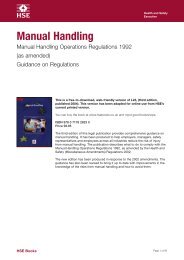Making Companies Safe - what works? (CCA ... - Unite the Union
Making Companies Safe - what works? (CCA ... - Unite the Union
Making Companies Safe - what works? (CCA ... - Unite the Union
You also want an ePaper? Increase the reach of your titles
YUMPU automatically turns print PDFs into web optimized ePapers that Google loves.
The relationship between knowledge and action<br />
‘Voluntary compliance’ strategies are based on an assumption that most employers want to<br />
protect <strong>the</strong>ir employees from workplace risks but simply lack <strong>the</strong> relevant knowledge. Raising<br />
standards is <strong>the</strong>refore seen as being largely a matter of providing information and advice,<br />
ra<strong>the</strong>r than enforcing <strong>the</strong> law.<br />
A key part of this question of <strong>the</strong> role of educational and advisory activities is <strong>the</strong> extent to<br />
which ‘having knowledge’ actually results in “action” that results in appropriate compliance<br />
with <strong>the</strong> law.<br />
A number of studies have demonstrated that <strong>the</strong>re is an association between <strong>the</strong> levels of<br />
knowledge employers’ possess about OHS and employers propensity to take action. 21 For<br />
instance, research on <strong>the</strong> impact of <strong>the</strong> Construction (Design and Management) Regulations<br />
found that whilst interviewees reported that <strong>the</strong> regulations were a major driver in improving<br />
health and safety standards it was also reported that lack of health and safety knowledge,<br />
particularly amongst clients and designers, was one reason for <strong>the</strong> limited implementation<br />
of <strong>the</strong> regulations. 22 And Eakin identified lack of awareness of health hazards and legal<br />
requirements as a significant factor in <strong>the</strong> failure of some organisations to comply with <strong>the</strong><br />
law or to improve <strong>the</strong>ir occupational health and safety performance. 23<br />
While research does show an association between levels of knowledge and understanding<br />
and propensity to initiate OHS improvements, this relationship is far from perfect. A number<br />
of studies indicate that firm knowledge does not necessarily translate into firm action. For<br />
example, <strong>the</strong> study by Rakel et al., discussed above, 24 found that non-compliance – across<br />
industrial sectors and in relation to specific health hazards – were present even when levels of<br />
knowledge and awareness were adequate. This was true, for instance, in relation to asbestos<br />
and chemical hazards, where levels of awareness amongst <strong>the</strong> firms inspected were<br />
judged to be extremely high, but where arrangements and precautions were judged to be<br />
inadequate. Rakel et al. observe that:<br />
“This may be related to <strong>the</strong> intuitive wisdom that suggests that it is one thing to<br />
know about health and safety issues and ano<strong>the</strong>r to translate this knowledge<br />
into action which might involve considerable expenditure.” 25<br />
Similarly, a comparative survey of OHS performance in <strong>the</strong> residential building sectors of<br />
Britain and Australia demonstrates that knowledge does not necessarily equate with action to<br />
improve OHS performance. Whilst British self-employed builders were found to have greater<br />
knowledge about OHS issues, this did not translate into greater regulatory compliance.<br />
Breaches of regulations were rationalised by employers in both countries on <strong>the</strong> basis of<br />
economic survival and minimal chances of detection. 26<br />
Wright also found that even amongst employers with good levels of OHS awareness and<br />
knowledge, organisational action taken in relation to different health or safety hazards could<br />
be highly inconsistent, and that a ‘genuine concern for safety’ for instance, ‘does not always<br />
lead to a concern for health management.’ 27<br />
This is illustrated by a study on industry attitudes towards noise-induced hearing loss.<br />
Thomson-MTS found that noise was not generally viewed as a priority hazard, and this was<br />
true even amongst managers reported as being “very health and safety conscious”. 28 This<br />
was primarily because noise was seen by management as a hazard that did not have an<br />
immediate impact and was not life-threatening. Similarly, Brazabon et al. found that less<br />
priority is placed on managing health hazards than safety hazards in <strong>the</strong> construction<br />
industry. 29<br />
O<strong>the</strong>r studies have found that compliance is uneven in relation to separate provisions within<br />
a single set of regulations. For instance, after reviewing a number of HSE-commissioned<br />
studies, Hillage et al. conclude that many employers:<br />
62<br />
“did not fully comply with <strong>the</strong> regulations, despite being aware of <strong>the</strong>m. In some<br />
cases it was specific details of <strong>the</strong> regulations that employers did not comply
















